Tokyo is one of the most electrically energizing, inspiring, and delicious places I've been to. I've had the privilege to explore it numerous times in the past few years, to visit markets, restaurants, and to cook some pop-up dinners myself. The chaotic intensity of this city makes it marvelous — but it can also be a tiring, anxiety-provoking place with dramatically different cultural norms.
Below is a constantly updating collection of my essential recommendations to optimize a trip to Tokyo, Japan.
Food
My first tip about food in Tokyo: try to be outgoing and befriend a Japanese person in any way possible. Ask if you can buy them dinner, provided they take you to their favorite classic spots around the city. If they take agree, I'm certain you'll have a better time than following my specific recommendations without an ability to read menus or communicate with servers.
If you're extremely lucky, a new friend will invite you for a home cooked meal, which is always the best way to really explore a new culture or community.
Picking a Random Place
If you're without a Japanese friend/guide, picking random restaurants is often the most fun, because there's no 45 minutes of stressful googling and still ending up at a lame tourist trap. Whatever you do, don't go on TripAdvisor, Yelp, or any other foreigner-leaning review sites.
I use Tabelog (the Yelp of Japan) to search for a well rated restaurant near me in a specific category, or I just head to a subway station or giant office building. Slowly walk around and follow hungry looking businessmen to a shop specializing in one type of cuisine, especially at lunch hours — you won't be disappointed.
Regardless, here are a few of my favorite categories of dining in Tokyo.
Oden
A traditional format of vegetables, meats, eggs, and more all cooked gently in boiling dashi broth. You can find oden street carts, but there are also some beautiful, traditional places hidden underneath buildings where old Japanese folks go for warming and light food, like Ogura Ginza
Ogura Ginza
Izakaya
While most restaurants in Japan focus on one thing, Izakayas are sort of pubs that serve many different styles of food, staying open super late, often 24/7. These are restaurants where it's acceptable, practically required, to go with a group, be a bit crazy, and drink overflowing bowls of sake. Just point at things other people are eating and ask to try them.
In Shibuya, there's tons of fun all-night izakayas, as well as a slightly higher-end seafood-focused spot called Kappore.
At night, walking around Akasaka there are many beautiful streets filled with fun and traditional Izakaya.
And in Shinjuku, an absurd high energy Izakaya with fish tanks in the center and a specialty of live squid sliced tableside: Squid Center Shinjuku.
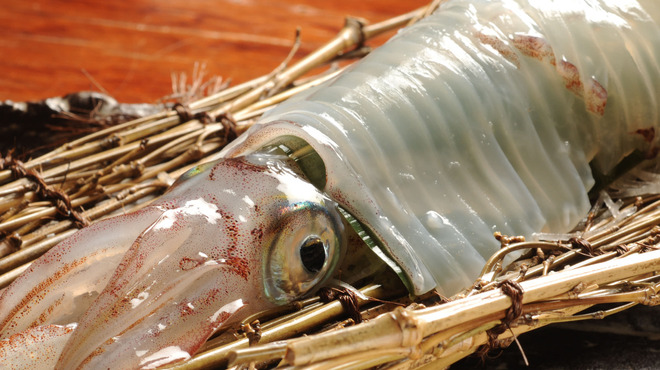
Yakitori
Dozens of specific cuts of chicken. White oak charcoal. Bamboo skewers. Cold beer. Another cold beer.
Brushed with soy sauce or seasoned simply with salt, yakitori is possibly my favorite Japanese style of dining. Any place with cold beers, happy businessmen, and an irresistible charcoal smell will do the trick.
I always get the chicken thighs with spring onion, hearts, livers, skin, and chicken sausage with a raw egg yolk to dip it in.
<iframe width="560" height="315" src="https://www.youtube.com/embed/-wMxeho0IXg?start=199" frameborder="0" allow="accelerometer; autoplay; encrypted-media; gyroscope; picture-in-picture" allowfullscreen></iframe>
Recommended: Jidoriya in Shimbashi There are plenty of places exactly like this, but I like coming to Jidoriya. It's inexpensive and super fun to sit at the bar and order a handful of skewers with cold beers. Get raw cucumber with miso to start.
For a higher end yakitori experience, try securing a reservation at Yoshicho, where you can enjoy a tasting menu of skewers. The quality of meat is so high that they'll serve you a few raw bites as well if you want.
Chicken sausage with soft egg
Crispy thigh and smoky quail eggs
Katsu
A delicious fatty pork chop or chicken, fried medium rare with an ultra crispy coating. Usually served alongside a dollop of super spicy mustard, and a giant pile of shaved cabbage dressed with a bright soy sauce.
Any respectable katsu places should bring you a little mortar and pestle with fresh sesame seeds, and a dark, sweet, sauce that's to my taste a better Japanese version of American BBQ sauce. Mixed together and used as a dip for your katsu, it's heavenly. Many places will moreover have a whole little DIY bar where you can assemble the exact toppings you'd like, drawing from different misos, pickles, sauces, and more.
 Set meal of fried crispy pork with cabbage and accoutrements.
Set meal of fried crispy pork with cabbage and accoutrements.
Soba
I've found chewy, savory buckwheat noodles to be astonishingly delicious in their subtlety, energizing healthiness, and technical prowess.
When you try soba, first taste the noodle alone to appreciate the chew and subtle nuttiness of buckwheat flour. Then take a small tangle of noodles, dip them into about 75% into the bowl of cold dipping sauce, and slurp loudly. After that, do what you want — you can add scallions and wasabi to the dipping sauce.
There's tons of delicious lunch spots for soba; add crispy fried shrimp, chicken, or a soft egg to fill a meal out if you're hungry. Hot broths with soba are totally acceptable to order but I almost always prefer that cold dipping soba showcase the flavor of the buckwheat better.
Sagara in Akasaka offers a dinnertime little series of three small soba bowls of different thickness and amount of buckwheat in the dough.
Watch this video excerpt to learn how to eat soba properly:
<iframe width="560" height="315" src="https://www.youtube.com/embed/0zJ287HHLMM?start=233" frameborder="0" allow="accelerometer; autoplay; encrypted-media; gyroscope; picture-in-picture" allowfullscreen></iframe>
Sushi
Kaiten conveyor belt sushi is fun, delicious, and super cheap. BUT: you can also try pretty excellent neighborhood sushi at the same price. Go in a shop where you can sit at the bar (it's always significantly better than at a table) and where normal people appear to be thoroughly enjoying their food.
Learn the names of fish that you like — I always order silver-skinned fatty fishes like iwashi (sardine) and aji (horse mackerel), as well as briny and sweet ama-ebi, raw giant prawns. To end the meal, I like asking for miso soup with tiny clams and a ume-shiso maki (a palette cleansing and awakening roll containing sour salted plums and herbaceous shiso).
Aji and Iwashi
For a fancy but affordable meal, go to Sushi Abe and try your best to sit at the counter. This is pretty excellent sushi served without the pretension or discomfort of many uber-fancy places.
If you do want to indulge in a super legit intimate sushi counter, try making a reservation at Sushi Takamitsu. Chef Takamitsu is extremely fun and funny, serving perfect ratios of cured fish to well-seasoned rice. He also offers an insane variety of sea urchin from around Japan:
Other
Only other spot I can think of at the moment is Ginza Shimada, a salaryman's standing-only restaurant with unique but traditional fare like a pile of perfect soba covered in grated bottarga, or a lovely crab cake.
Soba with Bottarga
Technology
Japan is far more technologically advanced than the USA, and having the right apps and tools really improves the experience of being a tourist.
It's really helpful to have a working data plan while in Japan — I rely constantly on a connected smartphone to translate, get directions, contact friends, and more. It's very difficult for foreigners to easily get a fully working cell phone with SMS and phone call capabilities — but thankfully it's easy to get a data plan.
If you have a phone with ESIM capabilities, download the Truphone or Gigsky apps. You can activate a virtual data plan with these carriers before you even land and your phone will work perfectly upon arrival, without having to change SIM cards. Otherwise, visit a few cell phone stands at the airport when you arrive — prices are reasonable for SIM cards that come with more than enough data.
Payments
American credit cards are rarely accepted in Japan, and slowly counting coins or bills will be super frustrating. However, most goods/service vendors accept digital payments.
If you have a phone with contactless payment abilities, download the SuicaEng app. After you create an account, load it with money, and connect it to your iOS or Android wallet, holding your phone near a terminal will automatically debit your account to pay for subways, taxis, vending machines, convenience stores, ramen shops...basically anything.
Just ask "Suica?" at a cash register if you're ever unsure. For subways, this technology is particularly magical: no waiting in line, holding on to tickets, simply hold your phone near the turnstyle when entering/exiting.
If you don't have a smartphone with contactless payment abilities, you can still get a Suica card at airports and major subway stations and use it in place of your phone for many, many establishments and services. If you're lazy, pay $10 extra and order one ahead of time online.
Typing
Installing a romanji keyboard on your smartphone allows you to type Japanese characters by spelling them out in English. This means you can type "soba" and your phone will automatically offer to replace it with そば. This comes in handy all the time, but most often when looking up directions or restaurants — for example, you'll always find many more soba restaurants by searching Google Maps for そば than for soba.

To install on an iPhone, go to Settings → General → Keyboard → Add New Keyboard → Add New Keyboard → Japanese → Romanji.
Travel
Looking up restaurant categories or keywords with a Romanji keyboard on Google Maps will deliver tons of results, and the app will help you navigate the subway to your destination perfectly. Your Suica makes paying for subway travel completely painless.
Although Tokyo is outrageously dense, it differs from most American cities in how many highways weave through its center. As a result, driving from one corner of the city to another can actually be relatively quick. However, if you wish to take a taxi, do note that they are pretty expensive; I would guess about Japanese taxis cost about 1.5x the price of their NYC counterparts.
To hail a taxi, head to a busy street and stick your arm out when you see a taxi with a bright red text lit up in the windshield (bright green text means the taxi is taken). Most taxi drivers do not speak English, so politely show them your map with your destination marked. Names of closeby major subway stations and hotels will help ensure you get to where you're going.
If you download the app JapanTaxi you can hail taxis using a ride-sharing user interface where you can enter the destination without having to attempt to explain where you're going. This is always way cheaper than using Uber, but Uber does work in Tokyo as well.
Translation
Google Translate is good to have on hand. Download the Japanese-English data completely so it will work even offline. The camera function dynamically translates any menus, signs, or text that you point it at.
Ultimately, though, expect to do a lot of pointing and charades.
Communication
First, you need to know how to say:
-
sumimasen –– "excuse me" for bumping into someone, asking for something at a restaurant, getting someone's attention...
-
arigato –– "thank you"
-
kudusai –– "please"
-
oishi –– "delicious"
So at a sushi restaurant, for example, you could say "Sumimasen, aji ngiri kudusai" and although the grammar is lousy and the sentence is basic, the chef will completely understand that you would politely like a piece of horse mackerel ngiri sushi. Then you can let the chef know "arigato...mmmmmm, oishi!" when it arrives and you taste it.
For digital communication, because your phone will only have data, prepare to communicate with friends and family using apps which can send text, audio, and video all over data. FaceTime, FaceTime Audio, WhatsApp, will work well, but download the app LINE if you want to connect with new Japanese friends — it's the preferred application and also allows for data-based voice and video calls.
Don't forget to get some dope souvenirs
Grocery Stores
Wherever I travel, I love to visit giant grocery stores to find great goodies to bring home. Read this great profile of Tokyo department store food halls in the Wall Street Journal.Throughout the city, the largest department stores have enormous and beautifully curated grocery markets in their bottom floors: generally one floor of curated stands and pop-ups selling delicacies, and a regular supermarket on the floor below. My favorite is the Shibuya Food Show, but Mitsukoshi in Ginza is wonderful, along with many many others.
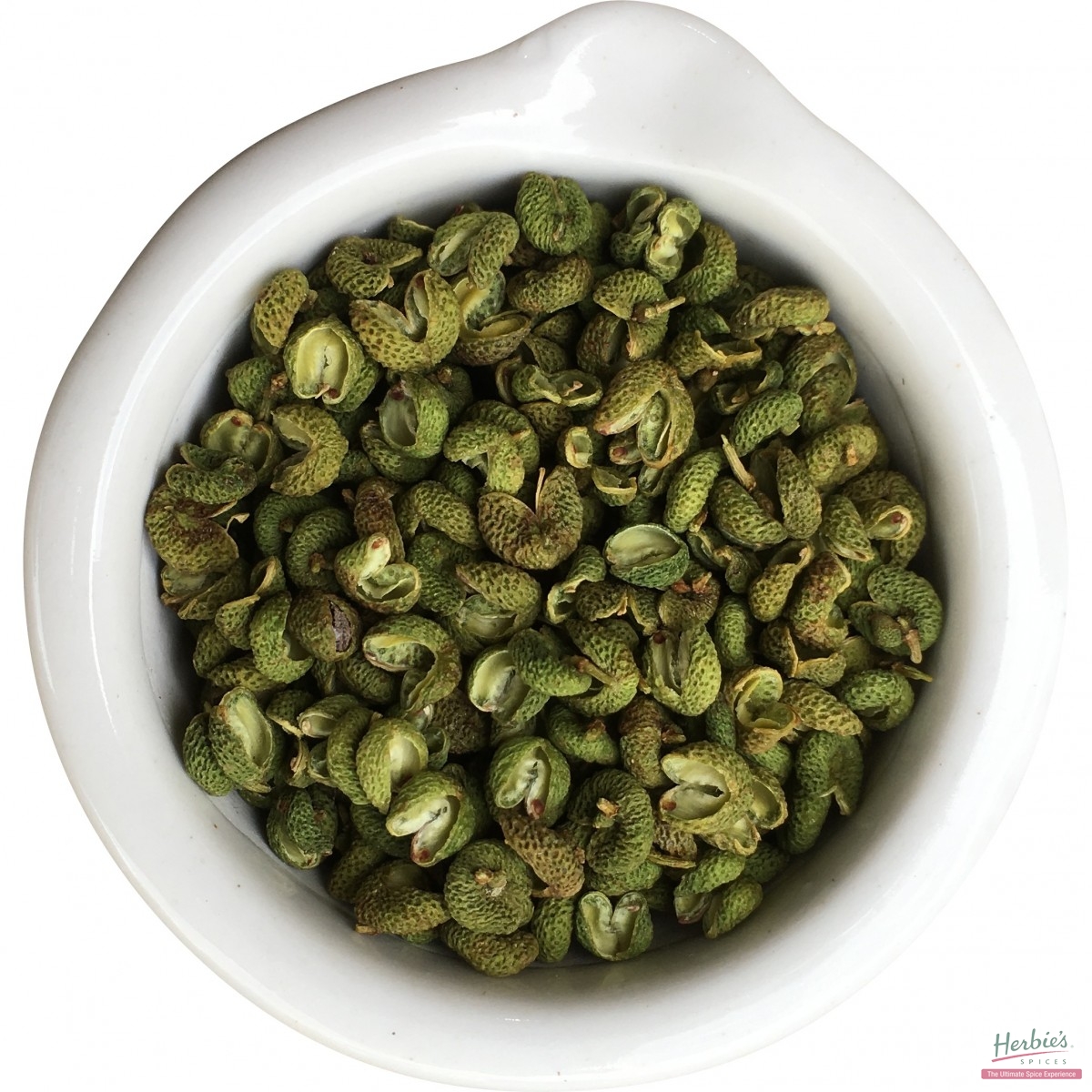 {:.small .right} You can get snacks to eat immediately, like well priced sashimi, soft serve ice cream, beautiful onigiri rice balls, and tempura galore. But the best goodies are those to take home: I always make sure to get tons of pickles, misos, whiskey, teas, and more. At the lowest level, where there's usually a normal supermarket, I get candies, snacks, and spices.
{:.small .right} You can get snacks to eat immediately, like well priced sashimi, soft serve ice cream, beautiful onigiri rice balls, and tempura galore. But the best goodies are those to take home: I always make sure to get tons of pickles, misos, whiskey, teas, and more. At the lowest level, where there's usually a normal supermarket, I get candies, snacks, and spices.
10/10 recommended activity.
Lifestyle and Cosmetic Stores
Muji, duh, has amazing bathroom and kitchen organizational items, great basic clothing, and amazing little snacks and candies.
I also highly recommend LOFT, a chain of department stores for home goods. LOFT carries floors and floors of incredible Japanese body products (soaps, bath salts, clay scrubs, and more), tableware (elegant plates, napkins, glasses, tea whisks, etc.), and stationary (traditional paper, pens, pencils, and more), all without a tourist markup.
 {:.small .right}
{:.small .right}
Japanese herbal bath salts from LOFT are about $3 each
Kapabashi Street
Kappabashi street, in Asakusa, is home to a few dense blocks of Japanese cooking appliances and tools. To be honest, some of the bigger stores here are kind of junky, but there are some gems as well.
You can find simple Japanese style denim aprons for $10, beautiful binchotan grills for DIY yakitori, wonderful knives, and much more.
My favorite is the hashi (chopstick) store where you can see all the different types of wood and bamboo that chopsticks are made from, as well as the important distinctions between different width, length, and pointiness of different chopsticks. I'd advise getting something very simple that showcases a nice single material — I personally took home the thinnest traditional bamboo chopsticks.
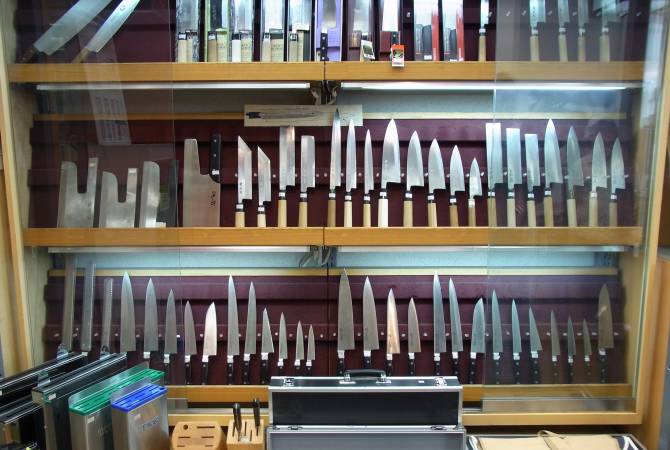
Antique Street
Antique Street has some wonderful stores selling legit tea ceremony bowls, traditional flower arranging tools, and beautiful functional and non-functional artworks.
I use ikebana (flower arranging) tools and vases all the time in my home, as well as tea bowls and whisks. They're a lovely way to integrate a trip to Japan back into your home hosting routines.
 Ikebana
Ikebana
Find Time to Leave Tokyo
Tokyo is amazing — but my love for Japan has deepened upon seeing how different the country is outside of this metropolis. If you can, take some time to explore outside. I've enjoyed visiting:
-
Kyushu, the southern island of Kyushu with its volcanic hot springs, wonderful fishing islands. Fukuoka and Kagoshima are two major cities, but take a boat ride or something to get into the middle of nowhere.
-
Shizuoka prefecture, only a few hours from Tokyo, where fresh wasabi is farmed, tons of top quality tea is grown, and Mount Fuji is located among breathtaking terrain.
-
Hokkaido, the largest northernmost island, with its vast mountains, hills, lakes, incredible fresh dairy, fresh fish, and uni.
 Hot tub jacuzzi in Hokkaido during winter.
Hot tub jacuzzi in Hokkaido during winter.

